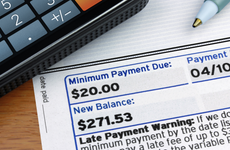Guide to credit card minimum payments

The Bankrate promise
At Bankrate we strive to help you make smarter financial decisions. While we adhere to strict , this post may contain references to products from our partners. Here's an explanation for . The content on this page is accurate as of the posting date; however, some of the offers mentioned may have expired. Terms apply to the offers listed on this page. Any opinions, analyses, reviews or recommendations expressed in this article are those of the author’s alone, and have not been reviewed, approved or otherwise endorsed by any card issuer.
How much do you put towards your credit card bill every month? Some people try to pay their balance off in full, while others put as much towards their credit card bill as they can afford. However, it’s important to always make the minimum payment on your credit card—no matter what else you’re dealing with financially.
What is a minimum payment? Simply put, it’s the lowest amount of money you can pay your credit card issuers every month without credit score damage. You can make only the minimum payment every month and still remain in good standing with your creditors.
However, if you only make the minimum payment on your credit cards, it will take you much longer to pay off your balances—sometimes by a factor of several years—and your credit card issuers will continue to charge you interest until your balance is paid in full.
What is the minimum payment on a credit card?
A credit card minimum payment is the lowest amount you can pay every month while keeping your account in good standing. Making at least the minimum payment on your credit cards every billing cycle ensures that you do not get stuck with late fees, penalty APRs or derogatory marks on your credit report.
While it’s a good idea to make more than the minimum payment every month—especially because your credit card issuer will charge interest on any balance remaining after you make your credit card minimum payment—making at least the minimum payment on your credit cards is one of the best things you can do to maintain a positive credit history.
How is a minimum payment on a credit card calculated?
A credit card minimum payment is usually calculated as a flat percentage of your total balance, although some credit card issuers may add new interest, fees and/or past due amounts to your minimum payment.
To find out how your minimum payment is calculated, check your credit card’s terms and conditions. If you have the Capital One Quicksilver Cash Rewards Credit Card, for example, your minimum payment for balances over $25 will be either $25 or 1 percent of your balance (whichever is greater), plus new interest, late payment fees and any past due amounts.
Not all credit issuers include credit card minimum payment calculators in their list of rates and terms. If you are not sure how your credit card minimum payment is calculated, contact your credit card issuer and ask “How much will my minimum credit card payment be?”
What happens if I don’t make the minimum payment on my credit card?
Paying less than the minimum on your credit cards can have serious consequences. Credit card issuers treat any credit card payment below the minimum as a missed payment, which can have negative effects on your credit score and credit history.
If you don’t make the minimum payment on your credit card, your missed payment will be reported to the three major credit bureaus: Equifax, Experian and TransUnion. The missed payment will appear as a derogatory mark on your credit history, and the negative mark could remain on your credit reports for seven years.
However, that doesn’t mean you should skip credit card payments when you can’t afford the minimum payment charge. Continuing to make payments on your credit cards even when you can’t afford to pay the minimum shows the credit card companies that you have not given up on paying back your debt—which can help you when it comes time to request credit card forbearance or negotiate a debt settlement.
How does missing a minimum payment affect my credit score?
Not making a credit card minimum payment can have a serious negative effect on your credit score. Your payment history makes up 35 percent of your FICO credit score and 40 percent of your VantageScore 3.0 credit score. The VantageScore 4.0 credit score, which uses trended data to track credit behaviors over time, lists payment history as “moderately influential” in determining your credit score.
Making on-time credit card payments is one of the most important parts of building good credit, and missing payments—or paying less than the minimum—is one of the quickest ways to damage your credit. Try to make at least the minimum payment on your credit card every month, and try to pay more than the minimum whenever you can.
Why you should pay more than the minimum
Making a credit card minimum payment may seem like a good idea, but it’s an even better idea to pay more than the minimum on your credit cards. Why? Because when you carry a balance on your credit cards, your credit card issuer will charge interest on your debt—and when you only make the minimum payment on your credit cards, those interest charges can quickly add up.
Want to know exactly how much money it’ll cost you if you only make the minimum payment on your credit cards? Thanks to the Credit CARD Act of 2009, your credit card issuers are required to tell you.
Check your monthly credit card statement for a box labeled “Minimum Payment Warning.” This box will tell you how long it will take you to pay off your debt if you only make the minimum payment on your credit cards, as well as how much money you’ll pay in total—an amount that will probably be significantly higher than your current credit card balance.
Here’s a quick overview of how long it can take to pay off a balance if you only make the minimum payment on your credit cards every month—and how much interest can accrue over time. In this example, you’re paying off a credit card with a $1,000 balance and a 17 percent interest rate, in which the minimum payment is calculated at 1 percent of the balance plus new interest.
| Month | Minimum Payment | Interest Paid | Principal Paid | Remaining Balance |
|---|---|---|---|---|
| 1 | $24.17 | $14.17 | $10.00 | $990.00 |
| 2 | $23.92 | $14.02 | $9.90 | $980.10 |
| 3 | $23.69 | $13.88 | $9.81 | $970.30 |
| 4 | $23.45 | $13.75 | $9.70 | $960.59 |
| 5 | $23.21 | $13.61 | $9.60 | $950.99 |
| 6 | $22.98 | $13.47 | $9.51 | $941.48 |
| 7 | $22.75 | $13.34 | $9.41 | $932.07 |
| 8 | $22.53 | $13.20 | $9.33 | $922.75 |
| 9 | $22.30 | $13.07 | $9.23 | $913.52 |
| 10 | $22.08 | $12.94 | $9.14 | $904.38 |
| 11 | $21.86 | $12.81 | $9.05 | $895.33 |
| 12 | $21.64 | $12.68 | $8.96 | $886.37 |
At the end of your first year you’ll have made $274.58 in payments while only reducing your $1,000 balance by $113.63. If you continued to only make the minimum payment, it would take you over nine years to pay off your debt—during which time you’d pay $857.52 in interest charges.
Tips for making your minimum payment
If you need help making a credit card minimum payment, you have a few options. Start by taking a look at your household budget and finding ways to cut back on your spending. Canceling a few streaming services or cutting back on takeout meals, for example, could help you set aside enough money for your credit card minimum payments.
If there isn’t any wiggle room in your budget, it might be time to look for ways to earn more money. Whether you’re checking out the best side hustles, looking into passive income or updating your resume before applying for a new job, bringing in extra cash is one of the best ways to tackle your extra credit card debt.
If you’re still coming up short, you can always contact your credit card issuer and ask them to reduce your minimum payment. Credit card companies have hardship programs designed to help people who are going through periods of financial difficulty, so take advantage of any assistance your issuer can offer.
The bottom line
Making the minimum payment on your credit cards will help you stay current with your credit card issuers, which is why it’s important to make at least the minimum payment on your credit cards every month. However, it’s a good idea to make more than the minimum payment on your credit cards whenever possible. Otherwise, you could end up paying a lot of extra money in interest—and you might stay in debt for much longer than you realize.
Related Articles



